- Home
- Media Kit
- Current Issue
- Past Issues
- Ad Specs-Submission
- Ad Print Settings
- Reprints (PDF)
- Photo Specifications (PDF)
- Contact Us

![]()
ONLINE

Investing in Haiti
“What is the dollar worth today?”
In business, the question usually means, how “strong” is the dollar compared with other international currencies?
But in the past year, charitable organizations, including the Knights of Columbus, have been learning how much “strength” the dollar can provide – when it is spent giving mobility and strength to amputee victims in Haiti.

Carl Anderson, Supreme Knight of the Knights of Columbus,
talks to an injured young woman at the
Project Medishare Hospital in Port-au-Prince.
In January 2010, Haiti’s massive earthquake killed a quarter million people – nearly 125 times greater than the number of deaths suffered in the United States from Hurricane Katrina.
But death did not have the last word in Haiti. The surviving injured number in the hundreds of thousands, and many still need basic treatments that could change their lives.
For example, an estimated 800 children have lost arms and legs.
If this had happened in the United States or many other countries, medical services and prosthetic limbs would be provided, and there would be hope for restored mobility.
But the situation in Haiti presents its own set of hurdles.
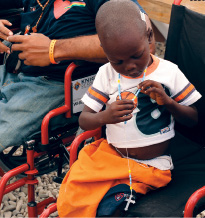
Health insurance is nonexistent, and depending on charity from your neighbors is unrealistic. When whole villages and cities have been devastated, no one has affluent neighbors. In a triage setting, it is often the children who get such specialized treatment last.
For these children and their families, the future is indeed bleak.
And because they are children, prosthetics are rare if not impossible to get for a simple reason: children are the last to get such medical treatment, and even if they do, as they grow up, they outgrow their prosthetics.
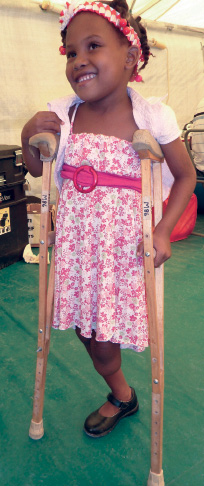
This was where the Knights of Columbus stepped in. The Knights learned that Project Medishare – which runs the premier hospital with care for children in Haiti – had a hope but no resources for developing a program for child prosthetics, and the Knights decided to do something.
Carl Anderson, Supreme Knight of the Knights of Columbus, noted that “those injured will live with the consequences of that day for the rest of their lives.” He said, “Those of us in a position to help, should do so, so that those in Haiti do not have to face alone the problems which we could help alleviate.”
Anderson unveiled a new initiative by the Knights of Columbus called Hope for Haiti’s Children.
The initiative offers the promise of a series of prosthetics and physical therapy to every child in Haiti who lost an arm or a leg in the disaster.
The Knights committed to the entire cost of the program – estimated at $1 million dollars – and will work with Project Medishare to deliver these medical services.
Though the biggest, this program was not the Knights of Columbus’ first step in helping Haiti. After the earthquake, the Knights of Columbus raised more than $600,000 for disaster relief there. Local councils held fundraisers and drives.
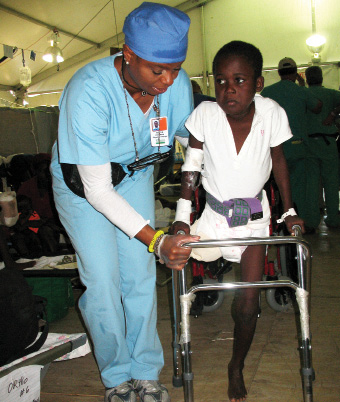
A pivotal moment came in April when a delegation from the Knights of Columbus – led by Supreme Knight Carl Anderson and Supreme Advocate John Marrella – went to Port-au-Prince to help distribute the first of more than 2,200 wheelchairs donated by the Knights to those injured, in partnership with Chris Lewis of the Global Wheelchair Mission, which has been a longtime partner of the Knights.
As a result of that trip, the Knights learned the story of a Haitian woman who had lost everything: her family, her home, and even her leg. When the medical site where she was being treated ran out of wheelchairs – leaving her without one – she said she had prayed that more people would come with wheelchairs.
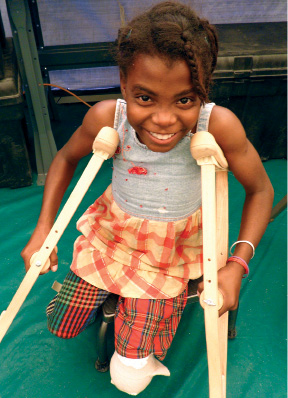
“She did not pray simply for the material necessities. Rather, she saw God as the provider of gifts through people,” noted Carl Anderson. “We want to be those people who give.”
The Global Wheelchair Mission estimates that 10 lives are changed for every wheelchair, including the family, friends, and caretakers of the recipient.
Added to that list should be “those who gave.”
Anderson said, “You can’t go home the same person when you lift someone off the ground and place them in a wheelchair. You can’t look at your wallet the same when you see how a $75 wheelchair changed their life.”
In light of the experience with providing wheelchairs for those in Haiti, going forward with the prosthetic program for children only made sense. It wasn’t something the Knights had done before, but it was something that badly needed to be done, and it was the right thing to do.
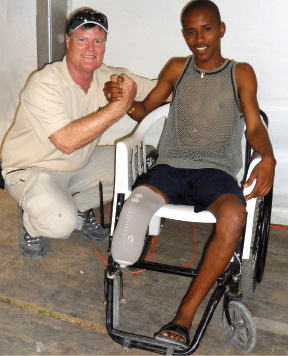
Prof. Robert Gailey, Ph.D. PT, Director of Rehabilitative
Services for Project Medishare with a young Haitian patient
According to Dr. Robert Gailey, Director of Rehabilitation Services for Project Medishare, “When the Knights of Columbus told me that they wanted to fit the children (with prosthetics), I knew this was an unusual and much-needed move.”
The challenge for the international community’s efforts in Haiti is not a lack of resources. Haiti’s international neighbors – including the United States – have plenty of resources.
The challenge remains for people to decide to give those resources.
So while the dollar can often be made to go far in one investment or another, the Knights of Columbus knows that its investment in the hope and future of Haiti’s youth is one of the best uses of the dollar – and one of the best investments – in the world.•